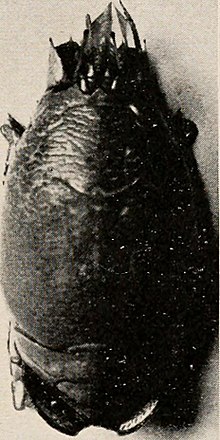Emerita talpoida, known generally as the Atlantic mole crab or Atlantic sand crab, is a species of mole crab in the family Hippidae. It is found in the western Atlantic Ocean and Mexico along the shoreline.[1][2][3]
| Emerita talpoida | |
|---|---|

| |
| Scientific classification | |
| Domain: | Eukaryota |
| Kingdom: | Animalia |
| Phylum: | Arthropoda |
| Class: | Malacostraca |
| Order: | Decapoda |
| Suborder: | Pleocyemata |
| Infraorder: | Anomura |
| Family: | Hippidae |
| Genus: | Emerita |
| Species: | E. talpoida
|
| Binomial name | |
| Emerita talpoida (Say, 1817)
| |
| Synonyms[1] | |
| |

Range
editThe Atlantic mole crab inhabits the swash zone of sandy beaches from Cape Cod south to the gulf Coast of Mexico.[4][2] It is one of seven New World Emerita species.[5]
Ecology
editLike all Emerita species, the Atlantic mole crab is a fossorial filter feeder. It requires moving water in order to feed, and it does so by burrowing itself backwards into the sand.[6] It uses its exposed feathery antennae to filter algae, detritus, and plankton.[7][8]
The Atlantic mole crab is an important food source for the Atlantic ghost crab, the blue crab, and certain species of fish in the swash zone.[9][8] Shorebirds, notably sanderlings have also been observed foraging for sand crabs.[10] The combination of its burrowing feeding strategy and its camouflaged carapace assist the Atlantic mole crab in evading predation.[8]
Because they spend much of their life in the swash zone, they can serve as a bioindicator for the effects of large-scale engineering works.[6]
Taxonomy
editEmerita talpoida was originally described as Hippa talpoida in 1817.[11] In 1879 a review of the family reassigned multiple species, including H. talpoida, from the genus Hippa to the genus Emerita.[12] The two are now considered sister genera.[12]
References
edit- ^ a b "Emerita talpoida". Integrated Taxonomic Information System. Retrieved 2019-09-25.
- ^ a b "Emerita talpoida". Global Biodiversity Information Facility. Retrieved 2019-09-25.
- ^ "Emerita talpoida species Information". BugGuide.net. Retrieved 2019-09-25.
- ^ "Atlantic Sand Crab Observations". inaturalist.org. Retrieved 2022-06-16.
- ^ Mantelatto, Fernando L.; Paixão, Juliana M.; Robles, Rafael; Teles, Jeniffer N.; Balbino, Felipe C. (2023). "Evidence using morphology, molecules, and biogeography clarifies the taxonomic status of mole crabs of the genus Emerita Scopoli, 1777 (Anomura, Hippidae) and reveals a new species from the western Atlantic". ZooKeys (1161): 169–202. doi:10.3897/zookeys.1161.99432. PMC 10206660. PMID 37234742.
- ^ a b Bowman, Dolan, Michael Lowell, Robert (1985). "The relationship of Emerita talpoida to beach characteristics". Journal of Coastal Research. 1 (2): 151–163. JSTOR 4297036.
{{cite journal}}: CS1 maint: multiple names: authors list (link) - ^ Kenneth Henry Mann (2000). "Sandy beaches". Ecology of Coastal Waters, with Implications for Management. Volume 8 of Studies in Ecology (2nd ed.). Wiley-Blackwell. pp. 218–236. ISBN 978-0-86542-550-7.
- ^ a b c Padre Island National Seashore. "Atlantic Sand Crab". U.S. National Park Service. Retrieved 2022-12-04.
- ^ Tewfik, Alexander; Bell, Susan S.; McCann, Kevin S.; Morrow, Kristina (2016). "Predator diet and trophic position modified with altered habitat morphology". PLOS ONE. 11 (1): e0147759. doi:10.1371/journal.pone.0147759. PMC 4732677. PMID 26824766.
- ^ Peterson, Charles H.; Bishop, Melanie J.; Johnson, Galen A.; D'Anna, Linda M.; Manning, Lisa M. (2006). "Exploiting beach filling as an unaffordable experiment: Benthic intertidal impacts propagating upwards to shorebirds". Journal of Experimental Marine Biology and Ecology. 338 (2): 205–221. doi:10.1016/j.jembe.2006.06.021.
- ^ Say, T. (1817). "An account of the Crustacea of the United States (continued)". Journal of the Academy of Natural Sciences of Philadelphia. 1 (1): 155–169.
- ^ a b Tam, Yan K.; Kornfield, Irv; Haye, Pilar A. (2002). "Molecular phylogenetics of mole crabs (Hippidae: Emerita)". Journal of Crustacean Biology. 22 (4): 903–915. doi:10.1163/20021975-99990302.
Further reading
edit- Nizinski, Martha S. (2003). "Annotated checklist of decapod crustaceans of Atlantic coastal and continental shelf waters of the United States" (PDF). Proceedings of the Biological Society of Washington. 116 (1): 96–157.
External links
edit- Media related to Emerita talpoida at Wikimedia Commons